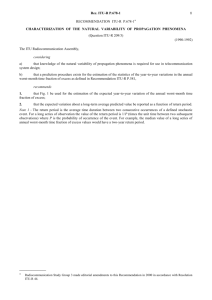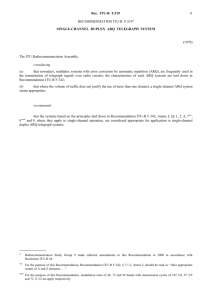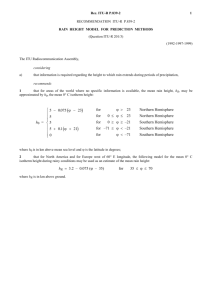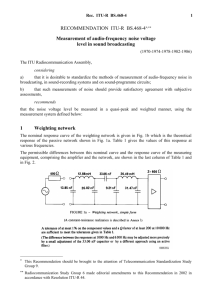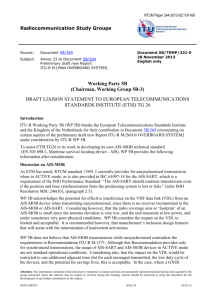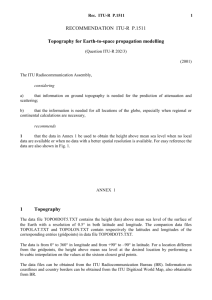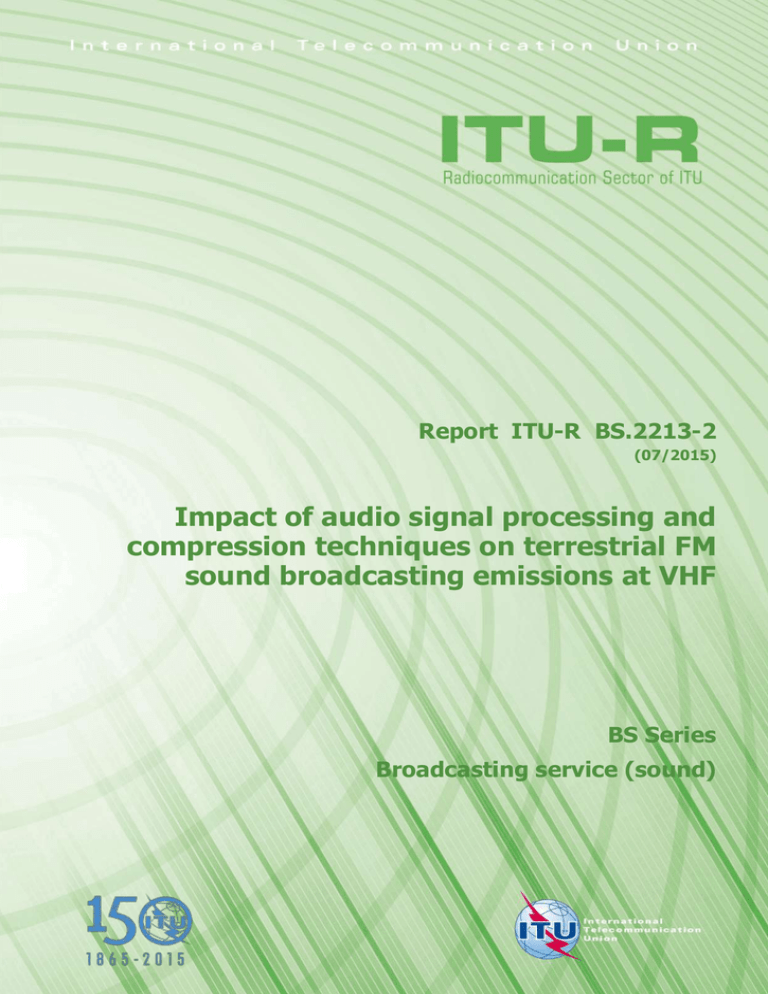
Report ITU-R BS.2213-2
(07/2015)
Impact of audio signal processing and
compression techniques on terrestrial FM
sound broadcasting emissions at VHF
BS Series
Broadcasting service (sound)
ii
Rep. ITU-R BS.2213-2
Foreword
The role of the Radiocommunication Sector is to ensure the rational, equitable, efficient and economical use of the radiofrequency spectrum by all radiocommunication services, including satellite services, and carry out studies without limit
of frequency range on the basis of which Recommendations are adopted.
The regulatory and policy functions of the Radiocommunication Sector are performed by World and Regional
Radiocommunication Conferences and Radiocommunication Assemblies supported by Study Groups.
Policy on Intellectual Property Right (IPR)
ITU-R policy on IPR is described in the Common Patent Policy for ITU-T/ITU-R/ISO/IEC referenced in Annex 1 of
Resolution ITU-R 1. Forms to be used for the submission of patent statements and licensing declarations by patent holders
are available from http://www.itu.int/ITU-R/go/patents/en where the Guidelines for Implementation of the Common
Patent Policy for ITU-T/ITU-R/ISO/IEC and the ITU-R patent information database can also be found.
Series of ITU-R Reports
(Also available online at http://www.itu.int/publ/R-REP/en)
Title
Series
BO
BR
BS
BT
F
M
P
RA
RS
S
SA
SF
SM
Satellite delivery
Recording for production, archival and play-out; film for television
Broadcasting service (sound)
Broadcasting service (television)
Fixed service
Mobile, radiodetermination, amateur and related satellite services
Radiowave propagation
Radio astronomy
Remote sensing systems
Fixed-satellite service
Space applications and meteorology
Frequency sharing and coordination between fixed-satellite and fixed service systems
Spectrum management
Note: This ITU-R Report was approved in English by the Study Group under the procedure detailed in
Resolution ITU-R 1.
Electronic Publication
Geneva, 2015
ITU 2015
All rights reserved. No part of this publication may be reproduced, by any means whatsoever, without written permission of ITU.
Rep. ITU-R BS.2213-2
1
REPORT ITU-R BS.2213-2
Impact of audio signal processing and compression techniques on
terrestrial FM sound broadcasting emissions at VHF
(2011-2013-2015)
TABLE OF CONTENTS
Page
Introduction ..............................................................................................................................
2
Annex 1 – Measurement results performed in Hungary on the protection levels against
interferers with exceeded MPX power in the FM sound broadcasting ..........................
2
1
Measurement setup and measurement methods .............................................................
3
1.1
Measurement of RF protection curves ................................................................
5
1.2
Measurement of the reduction of the peak deviation that can compensate the
effect of the higher MPX power .........................................................................
5
Measurement results .......................................................................................................
5
2.1
Measurement of RF protection curves ................................................................
5
2.2
Measurement of the reduction of the peak deviation that can compensate the
effect of the higher MPX power of the unwanted transmitter ............................
7
Appendix to Annex 1 – List of instruments .............................................................................
10
Annex 2 – Results of measurements performed in France on the protection levels against
interferers with exceeded MPX power in the FM sound broadcasting ..........................
11
1
The bench test .................................................................................................................
11
2
Measurement results .......................................................................................................
11
2.1
Statistical figure for the measurement analysis ..................................................
11
2.2
Results.................................................................................................................
11
Conclusion ......................................................................................................................
14
Appendix to Annex 2 – Measurement protocol .......................................................................
15
1
Introduction ....................................................................................................................
15
2
Bench test design ............................................................................................................
15
2.1
Filtered white noise according to Recommendation ITU-R BS.559-2 ...............
15
2.2
Multiplex power (MPX) variations on interfering transmitter ...........................
16
2.3
Bench test description .........................................................................................
18
2.4
Measuring process ..............................................................................................
20
2
3
2
Rep. ITU-R BS.2213-2
Introduction
Audio signal processing techniques have developed rapidly in the last few years based on advances
in digital signal compression techniques. Applying the compressed audio signal to the FM modulator
can increase the modulation power without exceeding the frequency deviation limit given in
Recommendation ITU-R BS.412. The processed modulation signal can also result in an increased
bandwidth so increasing interference to other VHF FM stations operating on the same or adjacent
channels.
Recommendation ITU-R BS.412-9 – Planning standards for terrestrial FM sound broadcasting at
VHF, provides the necessary RF protection ratios under the condition that the maximum deviation of
the interferer signal is 75 kHz and its multiplex power (MPX) does not exceed 0 dBr. Field
measurements show that nowadays a significant number of FM transmitters exceed the 0 dBr limit of
the MPX power and have a higher potential to cause interference in the reception of other FM
broadcast stations and in other radio services (e.g. air radionavigation). Recommendation
ITU-R BS.412-9 specifies that in these cases the transmitted RF power should be decreased, but does
not provide quantitative figures for the necessary reductions. As the FM band is overcrowded and
introduction of new digital stations is also considered, it is very important that the FM stations operate
in line with the international regulations.
As proposed in Question ITU-R 129/6 measurements were carried out to study:
–
What is the impact of audio signal processing and compression techniques on the average
power of the complete multiplex signal and the maximum deviation of the emission?
–
What techniques are available to ensure that the emission complies with the planning
parameters given in Recommendation ITU-R BS.412 when audio signal processing and
compression techniques are used?
This Report presents two summaries of measurements, one carried out in Hungary (Annex 1) and
another in France (Annex 2), in order to investigate how it can be ensured that the emission complies
with the planning parameters given in Recommendation ITU-R BS.412 when the 0 dBr MPX power
limit is exceeded due to application of audio signal processing and compression techniques.
Annex 1
Measurement results performed in Hungary on the protection levels against
interferers with exceeded MPX power in the FM sound broadcasting
Introduction
Recommendation ITU-R BS.412-9 – Planning standards for terrestrial FM sound broadcasting at
VHF, provides the necessary RF protection ratios under the condition that the maximum deviation of
the interferer signal is 75 kHz and its multiplex power (MPX) does not exceed 0 dBr. Using modern
audio processing/compressing techniques which result in an increase of the average power of the
complete multiplex signal may lead to an increase in interference to sound broadcasting stations
which do not use such techniques. Measurements were carried out in Hungary to investigate how can
be ensured that the emission complies with the planning parameters given in Recommendation
ITU-R BS.412 when the 0 dBr MPX power limit is exceeded due to application of audio signal
processing and compression techniques.
Rep. ITU-R BS.2213-2
3
Using modern audio processing/compressing techniques the 0 dBr MPX power limit can be exceeded
while the 75 kHz limit for the maximum deviation is kept. The increased interference potential of the
processed/compressed higher MPX power signal can be compensated either by decreasing the
transmitted RF power or by reducing the maximum FM deviation of the transmitter. The aim of the
measurements was to find quantitative figures for the reduction of the RF power and the peak
deviation of the FM broadcast signal exceeding the 0 dBr MPX power limit, which can restore the
audio signal-to-noise ratio (S/N) of the interfered FM broadcast service to the required 50 dB value.
1
Measurement setup and measurement methods
The measurements were carried out using the setup shown in Fig. 1 based on Recommendation ITU-R
BS.641 – Determination of radio-frequency protection ratios for frequency-modulated sound
broadcasting. The list of the instruments used and the main settings can be found in the Annex.
The signals of the wanted (Generator 6) and the interfering (Generator 7) transmitters were combined
and applied to the FM receiver. The output audio signal of the receiver was then measured by an
audio analyser.
The wanted signal was a stereo FM broadcast signal modulated by the output of the stereo coder while
the stereo coder was driven by internal 500 Hz sinusoidal sources in both (left and right) channels.
The level of the modulating signal was adjusted so that the peak FM deviation of the wanted signal
was 75 kHz and it remained unchanged during the whole measurement.
The interfering transmitter was modulated by processed/compressed noise plus RDS signal. The input
sound signal was a weighted (coloured) noise defined by Recommendation ITU-R BS.559-2
(see Fig. 1A), which was recorded on a CD. The level of the modulating signal was adjusted so that
the peak FM deviation of the unwanted signal was 75 kHz and it was checked by the modulation
meter (8). The RF level of the interferer signal could be adjusted by two cascaded step attenuators
((10) and (11)) in 1 dB steps.
FIGURE 1A
Weighted (coloured) noise defined by Recommendation ITU-R BS.559-2
(Hz)
10
100
1000
10000
100000
0
–5
(dB)
–10
–15
Left
–20
Right
–25
–30
–35
–40
–45
–50
Report BS.2213-01a
4
Rep. ITU-R BS.2213-2
The S/N ratio was observed at the audio output of the FM receiver (based on the specifications of
Recommendation ITU-R BS.468-4 – Measurement of audio-frequency noise voltage level in sound
broadcasting). The reference level of the signal was the level of the demodulated 500 Hz wave
measured at 75 kHz peak deviation while the unwanted signal (interferer transmitter) was switched
off. The level of the noise was measured using quasi-peak detector at the audio output of the FM
receiver while the 500 Hz modulation of the wanted transmitter was switched off. Then the S/N ratio
was calculated.
FIGURE 1
Measurement setup (the numbers in bracket refer to the list of equipment in Table 5)
RDS coder
(2)
Sound proc.
(3)
Generator
(SMR-20)
(7)
CD player
(1)
Dir. coupler
(9)
Mod. meter
(8)
Step atten. 10 dB
(10)
Generator
(Marconi)
(6)
Stereo coder
(5)
Step atten. 1 dB
(11)
Splitter (6 dB)
(12)
50/75 W
(13)
FM receiver
(14)
UPL Analyzer
(16)
Report BS.2213-01
Rep. ITU-R BS.2213-2
5
The RF level of the wanted transmitter at the input of the FM receiver was set to 49 dB(µV). It was
the lowest RF level where the S/N ratio at the output of the receiver reached the required 56 dB while
the interferer transmitter was switched off.
1.1
Measurement of RF protection curves
The measurement procedure of the RF protection curves was as follows. The multiplex power of the
interferer signal was set at the sound processor and was checked by the modulation and MPX power
meter (8). The interferer transmitter was tuned to the required frequency distance from the wanted
transmitter. The audio S/N ratio was observed at the output of the receiver and the step attenuators
were adjusted until the S/N ratio was set to 50 dB. The actual value of the RF protection ratio was the
difference in dB-s between the RF signal levels of the two transmitters. The measurement was
repeated with different frequency distances and with different multiplex powers.
1.2
Measurement of the reduction of the peak deviation that can compensate the effect of
the higher MPX power
The measurement setup was almost the same as in Fig. 1, except that a different type of audio analyser
(UPA) was used (for availability reasons). This measurement was completed only for 100 kHz
frequency difference between the two transmitters. The RF level of the interferer signal was 33 dB
below the wanted signal.
First the peak deviation of the interferer signal was set to 75 kHz in the test mode of the audio
processor. The processor keeps this peak value in normal operation mode regardless of the parameters
of the input sound signal and the programmed multiplex power. After setting a certain value of the
MPX power the signal-to-noise ratio was observed at the audio output of the FM receiver. Then the
level of the modulating signal at the output of the audio processor was adjusted until the observed
S/N ratio became 50 dB. This adjustment caused of course a change in the peak deviation of the FM
signal as well. The processor was then switched to test mode and the peak deviation was checked by
the modulation meter (8).
2
Measurement results
2.1
Measurement of RF protection curves
The results of the RF protection curve measurements are summarized in Table 1 and Fig. 2.
6
Rep. ITU-R BS.2213-2
TABLE 1
RF protection ratios for different multiplex power and
frequency difference values
Δf (kHz)
Multiplex power (dBr)
0
0.5
1.5
2.5
3.5
4.5
5.5
6.5
7.5
0
42.5
43
44
46
47
48
48
49
49
50
52
52
52
52
51
51
51
50
50
100
32.5
33
35
36
38
39
41
43
44
150
11
13
16
18
20
23
25
26
27
200
−11
−10
−7
−3
0
2
5
7
8
250
−26.5
−26
−25
−23
−21
−19
−16
−15
−13
300
−28
−28
−28
−28
−26
−28
−28
−28
−26
FIGURE 2
RF protection ratios for different multiplex power and
frequency difference values
RF protection ratio curves
60
50
RF protection ratio (dB)
40
30
20
10
0
–10 0
50
100
150
200
250
300
350
0 dBr
0.5 dBr
1.5 dBr
2.5 dBr
3.5 dBr
4.5 dBr
5.5 dBr
6.5 dBr
7.5 dBr
–20
–30
–40
Frequency difference between the wanted and the unwanted signals (kHz)
Report BS.2213-02
It can be seen that – in spite of certain expectations – the measured 0 dBr protection curve is not
identical with the S1 curve shown in Recommendation ITU-R BS.412-9. The most likely reasons of
the difference is that the S1 curve of Recommendation ITU-R BS.412-9:
a)
represents an average of the measurements made on a great number of different consumer
radio sets while for the present measurements only two different, medium quality radio sets
were used; and
b)
it was measured with an interferer signal with less than 0 dBr MPX power.
However, the curves clearly indicate the tendency that the higher the MPX power the more protection
is needed against it.
Rep. ITU-R BS.2213-2
7
From the above results we can also derive curves that show how much reduction of the RF power
level of an interferer signal can compensate its increased interfering effect if its MPX power exceeds
0 dBr, keeping the baseband audio S/N ratio at the required 50 dB. The three curves on Fig. 3 refer to
the 0 kHz, 100 kHz and 200 kHz difference between the carrier frequencies of the wanted and the
unwanted signal.
TABLE 2
RF power reduction that can compensate the effect of
the higher MPX power of the unwanted transmitter
Δf
(kHz)
MPX power (dBr)
0.5
1.5
2.5
3.5
4.5
5.5
6.5
7.5
0
0.5
1.5
3.5
4.5
5.5
5.5
6.5
6.5
100
0.5
2.5
3.5
5.5
6.5
8.5
10.5
11.5
200
1
4
8
11
13
16
18
19
FIGURE 3
RF power reduction that can compensate the effect of
the higher MPX power of the unwanted transmitter
RF power reduction vs. MPX power
Carrier power reduction (dB)
20
18
16
14
0 kHz
12
100 kHz
10
200 kHz
8
6
4
2
0
0
2
4
6
8
Multiplex power (dBr)
Report BS.2213-03
2.2
Measurement of the reduction of the peak deviation that can compensate the effect of
the higher MPX power of the unwanted transmitter
The higher interference potential of a signal exceeding 0 dBr multiplex power can also be
compensated by the proportional reduction of the FM deviation. Table 3 and Fig. 4 show the
applicable maximum deviations as a function of the original MPX power (before decreasing the peak
deviation). The two curves refer to the “on” and “off” state of the RDS signal.
The results of the measurements of the maximum applicable peak deviation are summarized in
Table 3 and Fig. 4.
8
Rep. ITU-R BS.2213-2
TABLE 3
Peak deviations for different MPX power values
Maximum applicable FM deviation (kHz)
Multiplex power (dBr)
RDS on
RDS off
1
71.5
69.7
2
61.5
63.3
3
56.8
56.8
4
51.6
50.4
5
48
46.9
6
46.3
43.9
7
45.1
42.2
FIGURE 4
Applicable peak deviations that can compensate the effect of
the higher MPX power of the unwanted transmitter
Maximum FM deviation vs. MPX power (kHz)
Maximal FM deviation (kHz)
80
70
60
RDS on
50
RDS off
40
30
20
10
0
0
2
4
6
8
Multiplex power (dBr)
Report BS.2213-04
The measurements were carried out both in the “on” and “off” state of the RDS signal. It was found
that this causes only a very slight difference.
The above results can be expressed in the reduction of the peak deviation – relative to the nominal
75 kHz – as well.
Rep. ITU-R BS.2213-2
9
TABLE 4
Reduction of the peak deviations that can compensate the effect of
the higher MPX power of the unwanted transmitter
(relative to 75 kHz)
Reduction of the peak FM deviation (kHz)
Multiplex power (dBr)
RDS on
RDS off
1
3.5
5.3
2
13.5
11.7
3
18.2
18.2
4
23.4
24.6
5
27
28.1
6
28.7
31.1
7
29.9
32.8
FIGURE 5
Reduction of the peak deviations that can compensate the effect of
the higher MPX power of the unwanted transmitter
(relative to 75 kHz)
Reduction of FM deviation vs. MPX power (kHz)
35
FM deviation reduction (kHz)
30
RDS on
25
RDS off
20
15
10
5
0
0
2
4
6
8
Multiplex power (dBr)
Report BS.2213-05
Conclusion
The laboratory measurements confirmed that FM broadcast signals with higher multiplex power can
cause higher degradation in the quality of the interfered FM broadcast signal. This degradation can
be compensated by decreasing either the RF level or the peak deviation of the interferer signal.
The above described measurements provide quantitative figures for the amount of these reductions.
10
Rep. ITU-R BS.2213-2
Appendix
to Annex 1
List of instruments
TABLE 5
List of instruments
No.
Equipment/type
Serial or Reg. No.
1
CD player (in an industrial PC)
L0064576
2
RDS coder
3
Audio processor Orban 5300 FM
4
Function generator Tektronix AFG 3252
5
Stereo coder R&S MSC-2
890340/017
6
Signal generator Marconi 2031 (wanted transm.)
119848/053
7
Signal generator R&S SMR-20 (unwanted transm.)
11040002.20
8
Modulation (and MPX) meter Audemat Aztek FM-MC4
9
High power directional coupler C5091 (Werlaton)
10
Step attenuator 8496A 10 dB
3308A14564
11
Step attenuator 8494A 11 dB
3308A32544
12
Resistive power splitter Aeroplex1870A
13
50/75 Ohm match RAM
100131
14
Radio set Sony S-master CMT-CPZ1
122234
15
Radio set Denon DN-U100
16
UPL Audio Analyzer R&S DC…110 kHz
17
UPA Audio Analyzer R&S 10 Hz 100 kHz
Signal and instrument settings
Signal level of the wanted transmitter at the receiver input:
Pilot signal:
FM deviation caused by the RDS signal:
UPL audio analyzer
Low-pass filter:
Detector:
Weighting filter:
UPA audio analyzer
Low-pass filter:
Detector:
Weighting filter:
53000135
L0062277
10279
8134
100091
49 dB(µV)
9%
3 kHz
on (15 kHz)
quasy-peak
on (weighting characteristics according to Recommendation
ITU-R BS.468-4)
on (22 kHz)
quasy-peak
on (weighting characteristics according to Recommendation
ITU-R BS.468-4)
Rep. ITU-R BS.2213-2
11
Audemat Aztec FM-MC4 modulation (and MPX) analyzer
Mode of operation: MPX Analysis Mode (In this mode the averaging time is automatically set to
200 ms and the MPX processing mode to “linear”).
Orban 5300 FM audio processor
Applied factory preset: “Extreme”.
Annex 2
Results of measurements performed in France on the protection levels against
interferers with exceeded MPX power in the FM sound broadcasting
1
The bench test
The French Administration has carried out a bench test using 26 receivers to study the impact of the
increase of multiplex power on protection ratios. The results of these measurements carried out in
France to quantify the impact of multiplex power over protection ratios (PR) when the limit of 0 dBr
is exceeded are included in this Annex, which provides quantitative figures of required protection
ratios, according to the values of multiplex power (MPX) used by some broadcasting FM stations.
2
Measurement results
2.1
Statistical figure for the measurement analysis
The ninth decile statistical figure has been chosen in order to show a representative analysis of the
measurement results. It was more representative than the median or the average to describe
the statistical behaviour of receivers during the experimentation.
Furthermore, the statistical ninth decile figures represent protection ratios of a theoretical receiver
which is less efficient than the 90% of the sample receivers tested.
The PR values taken as reference are given in Recommendation ITU-R BS.412-9 (§ 2.3.2, Table 3:
Stereophonic mode and steady interference).
2.2
Results
As shown in Fig. 6 below, some receivers (more than 10%) are protection ratio values close to those
found in Recommendation ITU-R BS.412-9, where no multiplex power applies to the interfered
signal at 100, 200, 300 and 400 kHz of the carrier frequency spacing.
12
Rep. ITU-R BS.2213-2
FIGURE 6
RF protection ratios for 0 dBr multiplex power and
carrier frequency spacing difference values for the 26 receivers tested
RF protection ratio (dB)
RF protection ratio curves – 0 dBr measured
f (kHz)
The bold red curve represents the PR in Recommendation ITU-R BS.412-9.
Figure 6 shows that the protection ratios given in Recommendation ITU-R BS.412-9 are still relevant
even if a lot of receivers have better protection ratios.
Figure 7 below shows several protection ratios measured for different values of multiplex power. As
indicated in § 2.1, the following curves represent a theoretical receiver which ensures that 90% of the
sample receivers tested will work properly.
Rep. ITU-R BS.2213-2
13
FIGURE 7
RF protection ratio curves for several multiplex power values using
frequency carrier spacing values (by steps of 100 kHz)
RF protection ratios (dB)
RF protection ratio curves
MPX (dBr)
As shown on Fig. 7, it is important to note that at 300 kHz and 400 kHz of the carrier frequency
spacing, the differences between the PR measured at 0 dBr multiplex power and at 9 dBr are very
low.
Thus, only carrier frequency spacing of 0 kHz, 100 kHz and 200 kHz are taken into account for
the final results.
Table 6 shows the value of the PR measured for different values of multiplex power applied to the
interfered signal at different carrier frequency spacings: 0, 100 and 200 kHz.
TABLE 6
RF protection ratios for different multiplex power and
frequency difference values
MPX
< 5 dBr
Δf
6 dBr
7.5 dBr
9 dBr
Rec. ITU-R
412-9
RF protection ration measured (dB)
0 kHz
42.5
42.5
42.5
42.5
45
100 kHz
32.0
36.5
37.5
39.5
33
200 kHz
8.0
10.0
11.0
13.0
7
According to the measurements made on receivers, for a multiplex power less than 5 dBr, the PR
obtained does not exceed: 42.5 dB at 0 kHz of the carrier frequency spacing, 32 dB at 100 kHz and
8 dB at 200 kHz.
14
Rep. ITU-R BS.2213-2
But for a multiplex power greater than 5 dBr, the PR measured keeps growing as the multiplex power
increases.
Compared to the PR values mentioned in Recommendation ITU-R BS.412-9, the decrease of RF
power that can counterbalance the effect of a higher multiplex power of the unwanted transmitter is
shown in Table 7.
TABLE 7
Decrease of RF power that can compensate the effect of the higher MPX
power of the unwanted transmitter
MPX
< 5 dBr
Δf
6 dBr
7.5 dBr
9 dBr
Rec. ITU-R
412-9
RF protection ration measured (dB)
0 kHz
+2.5
+2.5
+2.5
+2.5
45
100 kHz
+1.0
–3.5
–4.5
–6.5
33
200 kHz
–1.0
–3.0
–4.0
–6.0
7
The negative figures represent the necessary decrease of RF power that can compensate the effect of
multiplex power to ensure the protection of the wanted signal.
The positive figures show that PR values of Recommendation ITU-R BS.412-9 can be decreased by
each value according to the case considered. For example, for a carrier frequency spacing of 0 kHz,
the trial has shown the possibility to use 42.5 dB of protection ratio (between a wanted signal which
did not use the multiplex power and an unwanted signal which did use the multiplex power) instead
of 45 dB as indicated in Recommendation ITU-R BS.412-9.
3
Conclusion
The test bench results performed in France in 2012 have confirmed that FM broadcast signals with
higher multiplex power are degrading protection ratios and can worsen the quality of the interfered
FM broadcast signal. However, by widening the amount of receivers taken into account in the
measurements, the figures of the protection ratio obtained in Annex 1 are slightly different.
The main conclusion is that PRs in Recommendation ITU-R BS.412-9 are still relevant for multiplex
power that do not exceed 5 dBr for any frequency spacing between the wanted and the unwanted
signals. For signals that exceed 5 dBr, it is necessary to reduce the transmitter RF power according to
the values shown in Table 7.
Furthermore, the measurements show better performance for receivers put into market after 2010
(35% of the tested receivers). This could be due to a majority of 2010’s FM receivers using digital
components. This trend could enable the use of a lower protection ratio in the long term and a possible
revision of Recommendation ITU-R BS.412 if a new measurements campaign assessed it.
Rep. ITU-R BS.2213-2
15
Appendix
to Annex 2
Measurement protocol
1
Introduction
The bench test is based on Recommendation ITU-R BS.641 used to set protection ratios according to
the multiplex power variations and the spacing of carrier frequencies. The bench test involved a
representative sample of 26 receivers.
This document explains the methodology and the means used to carry out the bench test.
2
Bench test design
This first part explains how to get some technical elements required for the bench test:
1)
the coloured noise signal;
2)
the equipment that enables the multiplex power variations.
After that, the bench test is set up according to the diagram of measuring given in
Recommendation ITU-R BS.641.
The second part describes the bench test configuration, which is adapted in order to match with the
modern metrology methods.
2.1
Filtered white noise according to Recommendation ITU-R BS.559-2
The multiplex power variations depend on the noise modulating signal given in Recommendation
ITU-R BS.559-2. In order to obtain the coloured noise signal spectrum as defined in the
recommendation “…the spectral amplitude distribution of which is fairly close to that of modern
dance music…”, it is necessary to use a filtered white noise signal proceeding from an AF generator
signal according to the diagrams below (Figs 8 and 9).
FIGURE 8
Recommendation ITU-R BS.559-2 Filter diagram
Frequency/Amplitude AF measured
16
Rep. ITU-R BS.2213-2
FIGURE 9
Weighted (coloured) noise defined by Recommendation ITU-R BS.559-2
Audio Precision
+0
+0
-2.5
-2.5
-5
d
B
r
-5
-7.5
-7.5
-10
-10
-12.5
-12.5
-15
-15
-17.5
A
-17.5
-20
-20
-22.5
d
B
r
B
-22.5
-25
-25
-27.5
-27.5
-30
-30
-32.5
-32.5
-35
20
-35
50
100
200
500
1k
2k
5k
10k
20k
Hz
Sweep Trace Color Line Style Thick Data
------- Filter
1
1
Limit
Limit
1
2
Cyan
Cyan
Red
Red
Solid
Solid
Solid
Solid
1
1
2
2
Axis
Comment
------- Filtered white noise measured
FFT.ChA Amplitude
FFT.ChB Amplitude
Data 1 upperlimit
Data 2 upperlimit
Left
Right
Left
Right
The coloured
noise obtained was recorded in a specific VX222HR audio card from DIGIGRAM.
Click the "Sweep Spectrum/Waveform" swap button to switch between Frequency and Time
domain displays.
This file was saved in a PCM (48 kHz – 16Sty2_ANA_Bruit_Rec-559.ats2
bit) format and can be read by any professional audio
card. It just requires a digital or analog audio output.
The device SYSTEM TWO from AUDIO PRECISION was selected to provide a white noise signal.
(Set up: Noise – White Pseudo).
2.2
Multiplex power (MPX) variations on interfering transmitter
A
Principle
The MPX variation is achieved by using a sound processing system often used in the FM sound
broadcasting service.
The device selected is an OMNI ONE FM. It consists of a stereo coder, which embeds processing
and optimization sound features, used in FM sound broadcasting.
The OMNIA ONE FM can achieve the following functionalities:
1
Filtering at 15 kHz
2
Pre-emphasis of 50 µs
3
Limitation and optimization of level composite output in order to comply with the maximal
level fixed at 8.72Vc/c. This condition ensures that the maximum frequency deviation of
±75 kHz would not be exceeded.
The audio processing is based on AF signals dynamic compression techniques. The processing is
achieved by a set of cells working in a specific frequency band. Each audio frequency band, cut out
beforehand, is handled by a set of functions: dynamic compressor and limiter.
Then, the audio spectrum is reconstructed in order to be injected in the stereo coder. This last function
includes a clipper, which eliminates the over-shoot. This handling ensures to keep the MPX in a
tension range (8.72 Vc/c) and the maximum frequency deviation less than 75 kHz.
Rep. ITU-R BS.2213-2
17
Therefore, the AF signal dynamic range could be reduced according to the device settings. This
reduction increases the MPX of the signal.
The RF wanted signal is generated by a FM THOMSON-LGT RAMSES II transmitter. The stereo
coder integrated is put into operation.
B
Interfering signal line
The bench test interfering signal line consists of the following devices:
–
A PUC 2 YELLOWTEC card, which generates a coloured noise as a AES/UER signal
–
A set up Mono OMNIA ONE FM
–
A FM RVR PTX 100LCD transmitter.
Concerning the measurement in static mode, the following settings are used:
–
The control of the maximum deviation is achieved by the FMA of Rohde & Schwarz;
–
The spectrum analyser E4402B of HP shows the J0 carrier cancellation;
–
The modulating signal MPX is measured with the ADFM02 analyser.
Concerning the measurement in dynamic, following settings are used:
–
MPX variations and frequency deviations are analysed with the ADFM02.
This part of the bench test and its measurements modes are shown on Fig. 10.
FIGURE 10
Diagram of the interfering signal line
MPX
AES/UER
Sound card
OMNIA
ONE FM
Dynamic modulation
analyser
INPUT
ADFM02
RVR
(Laptop)
RF
Transmitter
FMA
AF generator
AF spectrum analyser
RF spectrum analyser
18
2.3
Rep. ITU-R BS.2213-2
Bench test description
The bench test is built according to the diagram of measuring apparatus reproduced below:
FIGURE 11
Diagram of the measuring apparatus
D01-sc
A modern version of this bench test is presented below. It contains, in a macroscopic model, all the
elements given in the reference diagram (Recommendation ITU-R BS.641). A correspondence
between the diagram given in the recommendation and the new version is shown below (Letters “A”
to “U”).
The tested equipment (the receiver) is put in a Faraday cage that shields the receiver from any radio
interferences around.
Rep. ITU-R BS.2213-2
FIGURE 12
Proposed bench test diagram
FIGURE 13
Wanted and interfering transmitters, clipper/Faraday Cage (at left) – measuring devices (At right)
19
20
2.4
Rep. ITU-R BS.2213-2
Measuring process
The measurement process used for the bench test follows exactly the methodology described in
Recommendation ITU-R BS.641.
The protection ratio is obtained when the following calculation is achieved:
PR = (P – Att ) – (P – Att )
U
U
B
B
Where:
P
Att
U
U
P
Att
B
B
is the RF wanted transmitter power
is the RF wanted transmitter attenuation that enables to fix the S/N at 56 dB,
when the interfering transmitter is not activated, as recommended
is the RF interfering transmitter power
is the RF interfering transmitter attenuation that enables to fix the S/N at 50 dB,
when the interfering transmitter is activated.
In order to ease the protection ratio calculation, the power level of wanted and interfering signal is
the same.
So the protection ratio is: PR = Att – Att .
B
U
This measurement process is also described in Fig. 14.
Rep. ITU-R BS.2213-2
21
FIGURE 14
Diagram of the measurement process
Bench test calibration
Tested equipment is set in the Faraday cage
AF gain receiver setting (RF level: 60 dBµV)
AF level = Max level
(@ THD+N<5%) – 10 dB => S
S level
Q-Peak
Without 15 kHz
Weighting filter
S/B1
AF 500 Hz => OFF
Noise level measurement => B1
B1 level
Q-Peak
With 15 kHz
Weighting filter
YES
RF wanted attenuator setting:
S/B2 = 56 dB
Total RF wanted
attenuation
AttU
S/B1 ≥ 56
dB ?
NO
RF wanted attenuator setting:
RF level = 60 dBµV
S/B2 = S/B1
Interfering transmitter MPX and frequency
deviations check
White noise filtered for each MPX value
RF interfering attenuator setting:
S/B3 = S/B2 – 6 dB
Protection ratio for each frequency deviation given
Total RF interfering
attenuation
AttB
PR* = AttB - AttU
* Interfering and wanted transmitters
powers are equal.

